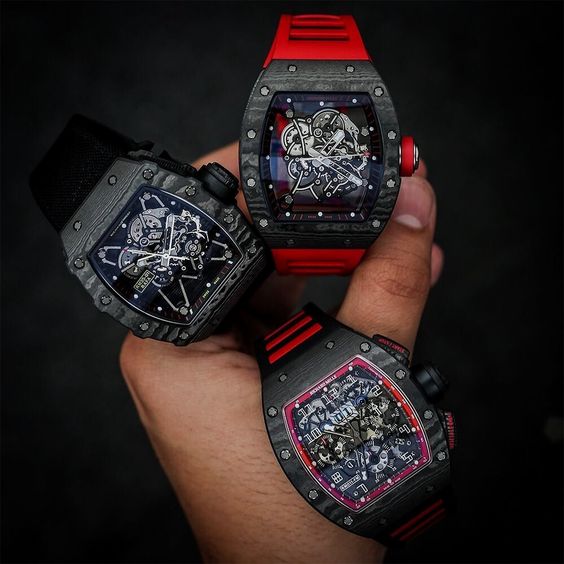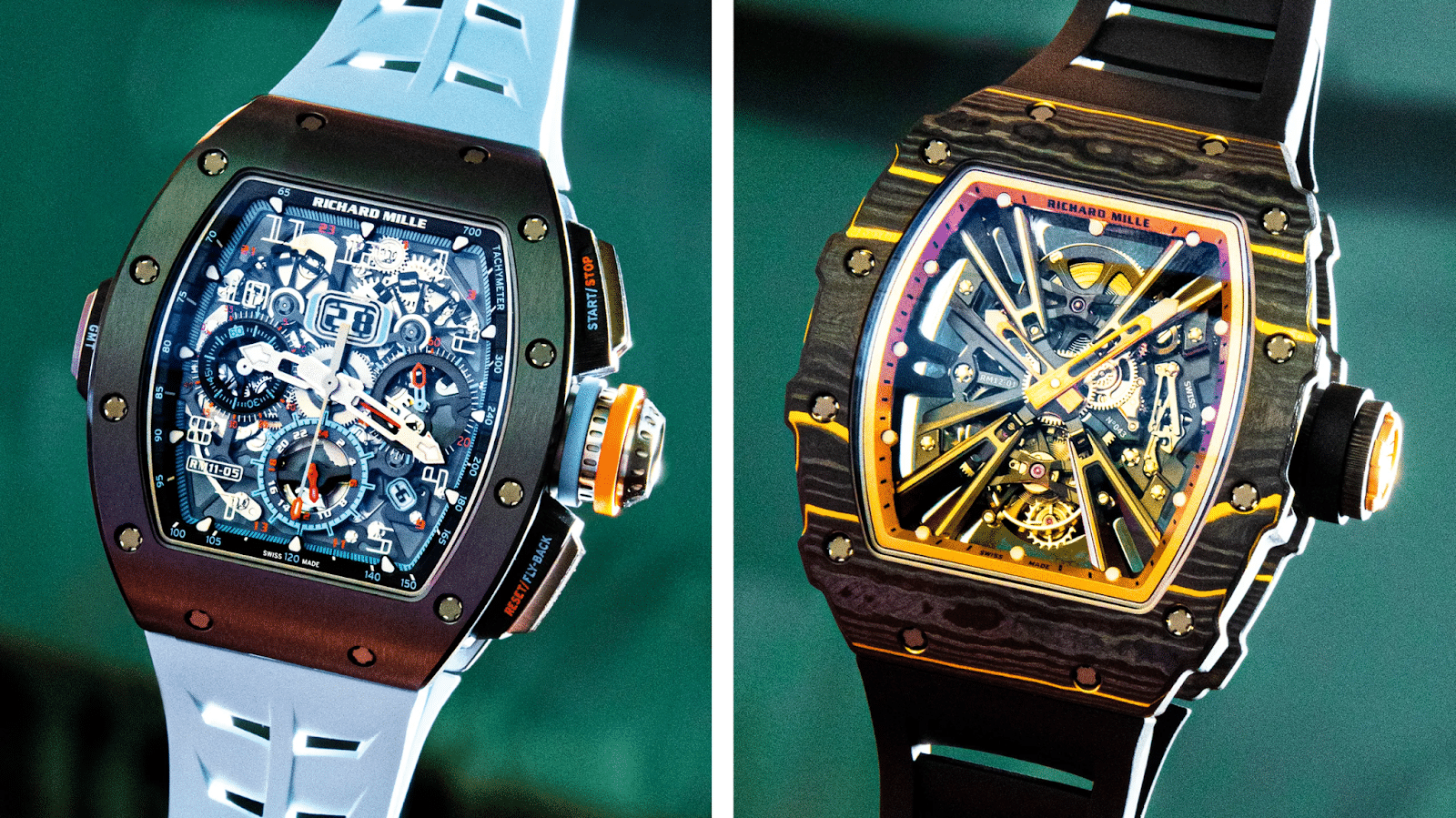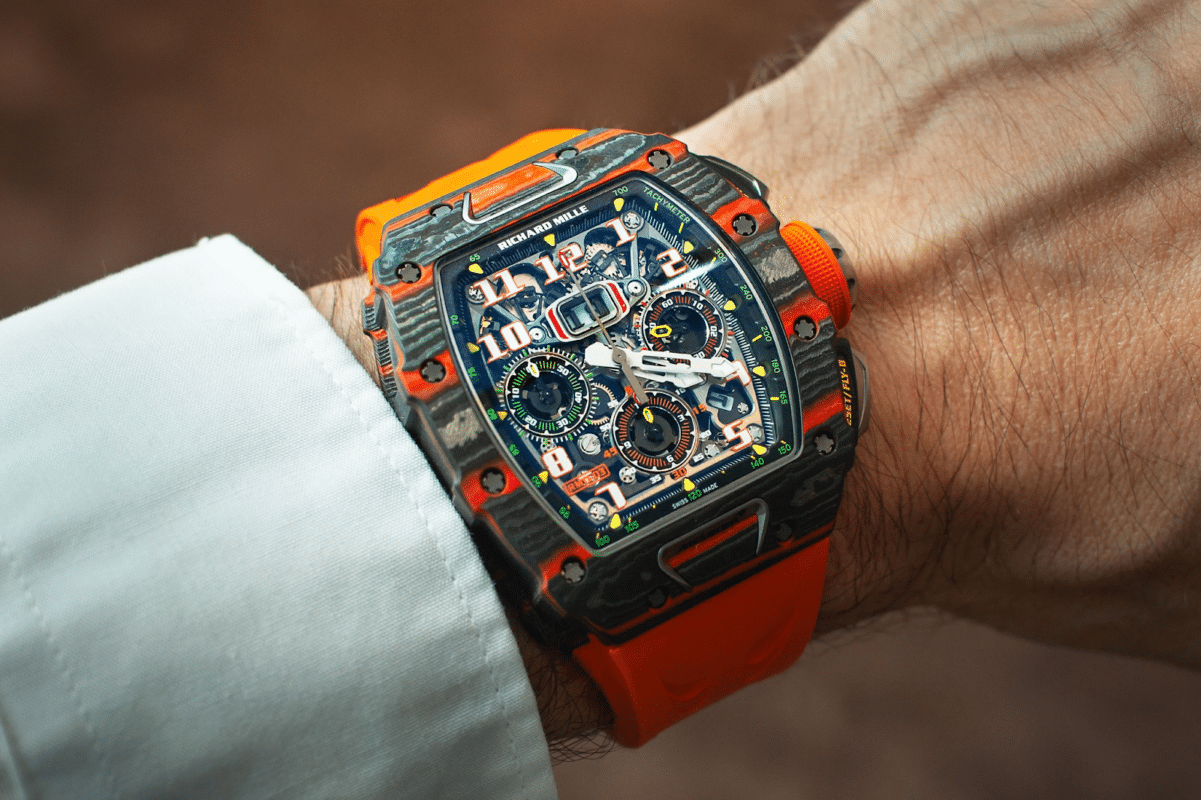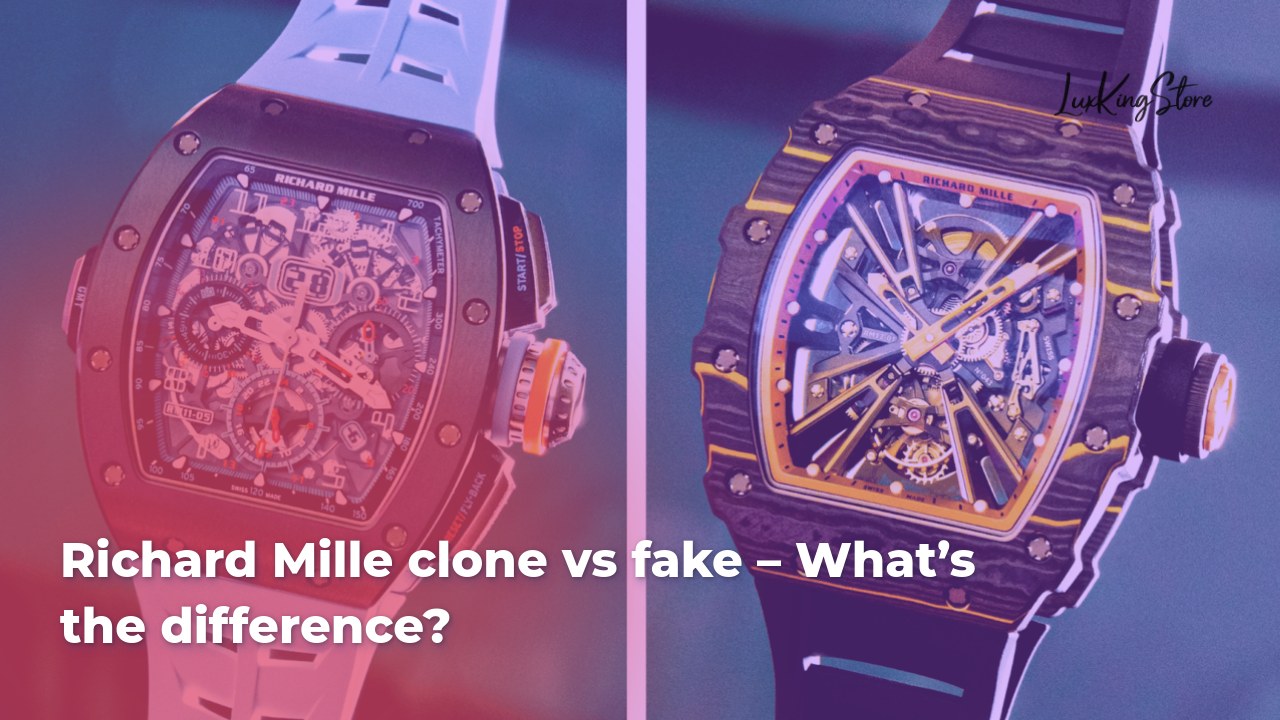Richard Mille clone vs fake – what’s the difference?
Richard Mille clone vs fake – what’s the difference?
In the world of luxury watches, few brands capture attention like Richard Mille. Known for their innovative designs and cutting-edge materials, these timepieces are not just accessories but status symbols. However, the market is filled with imitations, and understanding the distinction between clones and fakes is critical for both collectors and enthusiasts. While some clones attempt to replicate the grandeur of authentic Richard Mille watches, fakes present a diluted version that often falls short in quality and craftsmanship. In article Richard Mille Clone vs Fake: What’s the Difference?, we delve into the nuances of Richard Mille clones versus fakes, offering insights that will empower potential buyers to navigate this complex landscape confidently.
Understanding Richard Mille Watches
Richard Mille watches have earned their prestigious reputation through exemplary craftsmanship and innovative technology. Launched in 2001, the brand quickly distinguished itself from other luxury watchmakers by focusing on creating high-performance timepieces that embody avant-garde design while ensuring functionality. Authentic Richard Mille watches are characterized by their unique aesthetic appeal, utilizing advanced materials like titanium and carbon fiber, which not only enhance their durability but also keep them lightweight.
The intricate movements housed within these watches are another hallmark of quality. For instance, an impressive feature is the seamless second-hand motion a distinct trait associated with mechanical movements that sets Richard Mille apart from other luxury brands. More than mere timepieces, these watches function as pieces of art, with many showcasing a transparent case that allows aficionados to view the precision-engineered mechanisms at work.
One key aspect of authentic Richard Mille timepieces is the unique warranty card that accompanies each purchase, featuring a holographic seal to prevent counterfeiting. This ensures buyers that they are investing in a genuine product. In contrast, the market is saturated with clones and fakes. Understanding how to differentiate genuine Richard Mille watches from these imitations requires a keen eye for detail and an awareness of the specific characteristics that define the brand.
Key Features of Authentic Richard Mille Watches
- Material Quality: Titanium and carbon fiber are standard, contributing to the lightweight feel.
- Mechanical Movements: Precision-engineered movements allow for seamless functionality.
- Warranty and Authentication: Holographic seals and unique serial numbers on warranty cards safeguard authenticity.
- Aesthetic Appeal: Avant-garde designs that cater to luxury watch enthusiasts.
By educating oneself on these facets, buyers can better appreciate the artistry behind genuine Richard Mille watches and make more informed purchasing decisions.

Characteristics of Richard Mille Clones
Richard Mille clones, often referred to as “super clones,” are designed to imitate the aesthetics and style of genuine Richard Mille watches closely. While they aim to replicate the appearance of the originals, significant variances in material quality, movement, and overall craftsmanship exist. Here are some defining characteristics of Richard Mille clones:
- Aesthetic Similarity: Clones often mimic the overall look, color schemes, and unique design features of authentic Richard Mille watches, making them visually appealing at first glance.
- Material Choices: Though better than standard fakes, clones do not typically use the premium materials found in authentic pieces. It is common to see a combination of decent metals and fabric, striving to offer a comparable look without the high-end quality.
- Movement Quality: Many clones employ reliable quartz movements, which offer decent timekeeping, although they often fall short of the precision of genuine mechanical movements.
- Price Point: Clones are significantly more accessible than authentic watches, generally ranging from $699 to $1,599. This pricing makes them an attractive option for those who admire the design without the accompanying hefty price tag.
- Craftsmanship: While clones can showcase better craftsmanship compared to low-quality fakes, they often still lack the immaculate finish present in genuine watches, exhibiting minor flaws in details, such as misaligned logos or uneven edges.
Characteristics of Richard Mille Clones:
- Visual Accuracy: Close resemblance to genuine watches.
- Mid-Quality Materials: Better alternatives than fakes; however, still inferior to originals.
- Reliability: Quartz movements that provide time accuracy.
- Affordability: Priced between $699 and $1,599.
- Craftsmanship Differences: Notable variances in detailing when compared to authentic models.
Understanding these characteristics is crucial for those considering a clone. While they offer a more budget-friendly alternative to fans of the brand, it’s important to recognize that they do not match the authentic experience in terms of quality or craftsmanship.
Distinguishing Features of Fake Richard Mille Watches
Fake Richard Mille watches represent a more substandard imitation that often lacks the sophistication of both clones and genuine models. Identifying these fakes requires an understanding of their typical attributes, which can often be spotted with a discerning eye. Here are some key distinguishing features:
- Poor Material Quality: Fake watches frequently use low-grade metals or even plastic components, resulting in a cheap feel and appearance.
- Inconsistent Craftsmanship: Displaying rough edges, inconsistent finishes, and poorly applied logos are common signs of counterfeit watches. Buyers can often identify fakes through less-than-perfect attention to detail.
- Movement Issues: Many fake watches employ battery-operated quartz mechanisms. Unlike high-end mechanical movements, these watches often tick audibly a significant giveaway that it is not a true Richard Mille timepiece.
- Pricing Red Flags: Accurate pricing comparisons can reveal fakes. Genuine Richard Mille watches start around $85,000, while fakes can often be found for under $1,000. If a deal seems too good to be true, it likely is.
- Lack of Authentic Documentation: Unlike authentic Richard Mille watches, fakes typically do not come with a credible warranty card or proper documentation. This absence serves as a clear indicator of their illegitimacy.
Common Features of Fake Richard Mille Watches:
- Inferior Materials: Plastic and low-grade metals dominate.
- Craftsmanship Flaws: Poor finish quality with noticeable errors.
- Movement Type: Often use quartz movements, leading to audible ticking.
- Suspect Pricing: Typically range under $1,000.
- Missing Warranty Cards: Lack of proper documentation is common.
By being aware of these distinguishing features, you can better protect yourself from falling victim to counterfeit Richard Mille products. Identifying authentic versus fake watches can safeguard your investment in luxury timepieces.
Quality Comparison: Clones vs Fakes
When comparing the quality of Richard Mille clones and fakes, significant discrepancies arise that are important for potential buyers to understand. The table below summarizes key quality indicators between the two:
| Feature | Richard Mille Clones | Fake Richard Mille Watches |
|---|---|---|
| **Material Quality** | Decent alternatives to original materials | Low-grade metals or plastic |
| **Craftsmanship** | Better attention to detail | Poor workmanship with flaws |
| **Movement Type** | Often quartz; mimics mechanical movement | Typically battery-operated, giving audible ticking |
| **Durability** | More durable for everyday use | Generally, less durable, prone to functional issues |
| **Visual Authenticity** | Close resemblance to genuine models | Noticeable differences at closer inspection |
Analysis of Quality Indicators:
- Material Quality: Clones typically utilize reasonable alternatives, while fakes are heavily inferior, compromising both feel and longevity.
- Craftsmanship: The manufacturing process involved in creating clones usually allows for better craftsmanship than the haphazard production of fakes. This can significantly affect the overall presentation and fate of the timepiece.
- Movement Type: Clones often adequately imitate the exquisite nature of mechanical movements found in authentic models, while fakes primarily rely on basic quartz technology, decreasing their overall sophistication.
- Durability and Aesthetics: Clones can withstand everyday wear with their competent design; fakes often succumb to wear quickly, leading to performance issues.
By identifying the differences in quality between Richard Mille clones and fakes, buyers can make informed decisions when it comes to luxury horology.

Price Range: Clones vs Fakes
Understanding the pricing structure between Richard Mille clones and fakes is essential for buyers to ensure they are making a sound investment. The following table details the average price range for each category:
| Type | Price Range | Description |
|---|---|---|
| **Richard Mille Clones** | $699 – $1,599 | Affordable replicas with reasonable quality |
| **Fake Richard Mille Watches** | Under $1,000 | Often poorly made and easily distinguishable |
Pricing Analysis:
- Clones: The price range of $699 to $1,599 makes clones a more accessible alternative to enthusiasts who love the design of Richard Mille watches but are unwilling to pay exorbitant prices associated with authentic models, which can start at around $85,000.
- Fakes: Priced below $1,000, fake watches appeal to budget-conscious buyers but lack the quality, durability, and investment potential of authentic or cloned pieces.
It’s important to research prices and be aware of market trends before making a purchase. Understanding the financial implications associated with each option can help buyers avoid regrettable deals.

Market Perception: Clones vs Fakes
The watch community has divergent perceptions of Richard Mille clones versus fakes, which influence buyers’ choices. Here’s a breakdown of how the market views each category:
Market Perception Analysis:
- Richard Mille Clones:
- Acceptance: Many collectors and enthusiasts view high-quality clones as legitimate alternatives for those who appreciate the aesthetics of Richard Mille watches but cannot afford the original prices.
- Community Circles: Clones are often discussed within enthusiast circles as a way to enjoy the luxury aesthetic without the financial burden of authentic pieces.
- Fake Watches:
- Skepticism: Fakes are generally regarded with disdain within the watch community as they not only misrepresent the brand’s intellectual property but also contribute to the erosion of the brand’s reputation.
- Quality Concerns: The poor craftsmanship and inferior materials associated with fake watches lead to skepticism about their reliability and durability.
By understanding these perceptions, potential buyers can navigate their options with greater clarity, balancing personal preference with community sentiment.
Collectibility: Are Clones Worth Investing In?
When considering the investability of Richard Mille clones, it is essential to evaluate several factors regarding their collectible nature. Clones often bridge the gap between affordability and aesthetic appreciation, but do they hold any real investment value?
Evaluation of Collectibility:
- Investment Potential: While Richard Mille clones may offer an appealing visual alternative to enthusiasts, they generally do not hold the same long-term investment potential as original models. Authentic timepieces are often regarded as investments, retaining or increasing their value over time due to brand prestige and rarity.
- Aesthetic Appeal: Clones can satisfy the desire for luxury aesthetics, providing buyers with a sense of enjoyability without the necessary expenditure for genuine watches; however, this enjoyment may lack the lasting appreciation associated with true collectors.
- Market Demand: The low price point and growing demand for affordable luxury options may create a niche market for clones, but their lack of brand authenticity may restrict their mainstream acceptance.
In summary, while Richard Mille clones provide a satisfying alternative for enthusiasts, they often lack the profound investment and collectible potential associated with genuine Richard Mille watches.

Performance and Functionality: Clones vs Fakes
The performance and functionality of watches are paramount, especially in the realm of luxury timepieces. Here’s a comparative breakdown of how Richard Mille clones and fakes stack up in this regard:
Performance Comparison:
- Richard Mille Clones:
- Reliability: Many clones utilize quartz movements, allowing for reliable timekeeping, though they may not achieve the same complexity as mechanical movements. Despite this, the quality of these movements can be superior to that commonly found in fakes.
- Durability: Clones typically employ more durable materials than their fake counterparts, making them suitable for regular use.
- Fake Richard Mille Watches:
- Reduced Functionality: Fakes often feature basic, low-quality movements. This results in inaccurate timekeeping and, in some cases, durability issues that can arise from subpar construction.
- Performance Issues: Because of their construction with inferior materials, these watches may fail to perform crucial functions over time, leading to inconsistent timekeeping.
Whether you’re drawn to aesthetic appeal or performance, understanding the distinctions in functionality helps elevate your knowledge and purchasing confidence.

Where to Buy Clones and Fakes
Navigating the market for Richard Mille clones and fakes can be tricky. Understanding where these watches are commonly sold can help you avoid counterfeit products:
- Online Marketplaces: Websites like eBay, Wish, and various unauthorized online watch dealers often sell both clones and fakes.
- Social Media Groups: Certain platforms allow users to buy and sell watches, which can lead to potentially unsafe transactions without clear provenance.
- Low-Priced Offers: Be wary of prices significantly lower than the authentic Richard Mille offerings, which start around $85,000. This is often indicative of a fake.
- Unauthorized Dealers: Shopping from unknown websites or sellers lacking a strong reputation in the watch community increases the risk of purchasing counterfeit products.
Recommendations for Safe Buying:
- Conduct Thorough Research: Understand the price ranges and watch characteristics to ensure your purchase is legitimate.
- Check Reviews: Wherever you shop, look for reviews and feedback from other users to gauge the reliability of the seller.
By using due diligence in your purchasing decisions, you can minimize the risk of acquiring counterfeit Richard Mille watches.
How to Spot a Fake Richard Mille
Spotting a fake Richard Mille is key to ensuring that your purchase is genuine. Here are some essential tips for identifying counterfeits:
- Price Check: Authentic Richard Mille watches start around $85,000; any offering below this price is likely a fake.
- Material Assessment: Genuine watches use high-quality materials like titanium and carbon fiber. If a watch feels heavy or is made of inferior materials, it’s probably a fake.
- Examine Craftsmanship: Authentic models feature immaculate detailing with sharp logos and smooth edges, while fakes often present inconsistencies and rough finishing.
- Check the Movement: If the watch ticks audibly or has a visible battery, it is a fake.
- Warranty Card: Genuine watches come with a warranty card that includes a unique serial number and a holographic seal.
By honing in on these characteristics, buyers can increase their chances of identifying genuine Richard Mille pieces and protecting their investment.

Conclusion: Which Is Better – Clone or Fake?
Ultimately, while Richard Mille clones present a more aesthetically pleasing and higher-quality option compared to fakes, they still lack the exceptional craftsmanship and prestige associated with authentic watches. Clones may satisfy the desire for luxury appreciation without the financial burden, but they do not serve as true investments due to their limited appreciation potential and collectibility.
On the other hand, fakes are generally condemned for their poor materials and craftsmanship, lacking integrity and quality. For those who cherish the artistry behind Richard Mille watches, investing in authentic pieces or reliable clones may be the best course of action ultimately providing the satisfaction of owning a timepiece that lasts and retains value over time.
FAQs
- What is the price range for authentic Richard Mille watches?
- Authentic Richard Mille watches start at around $85,000 and can go up to $2 million for exclusive editions.
- Can I tell the difference between clones and fakes?
- Yes, clones often mimic the aesthetic of original watches decently, whereas fakes usually exhibit poor craftsmanship.
- Why are Richard Mille clones so popular?
- They allow luxury enthusiasts to access the aesthetic of high-end watches without the exorbitant prices.
- Is it safe to buy Richard Mille clones?
- While some clones are of reasonable quality, it’s essential to purchase from reputable sources to ensure they are not fakes.
- How can I prevent buying a fake Richard Mille watch?
- Always check the price, material quality, craftsmanship, and authenticity documentation before making a purchase.
Key Takeaways
- Richard Mille watches are known for innovative design and high-quality materials.
- Clones attempt to replicate authentic watches but lack the quality and investment potential of originals.
- Fakes generally exhibit poor craftsmanship and low-quality materials, contributing to ongoing skepticism in the watch community.
- Understanding pricing and recognizing distinguishing features can help protect buyers from counterfeit products.
- While clones offer an alternative for design appreciation, investing in authentic pieces ensures quality and retains value.
Suggested Keywords
- Richard Mille clone
- Richard Mille fake
- Buying guide for luxury watches
- Differences between clones and fakes
- Luxury horology craftsmanship
With this comprehensive perspective on Richard Mille clones and fakes, you are equipped to navigate the intricate world of luxury watches, ensuring that your investment in timepieces is both satisfying and secure.
You Can See More Product: Richard Mille clone vs fake – what’s the difference?

